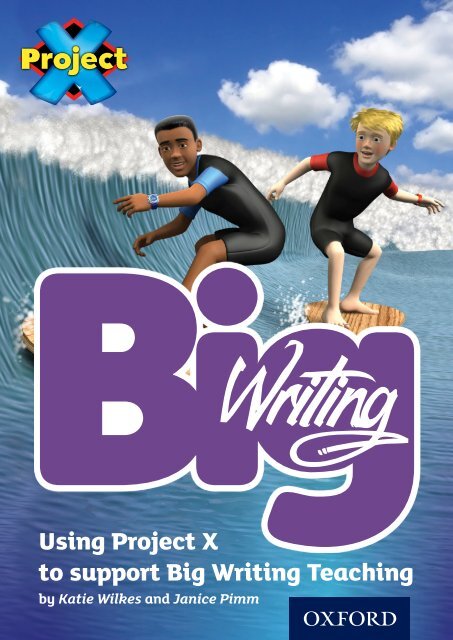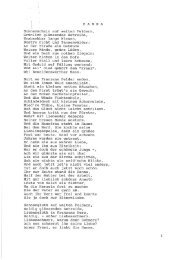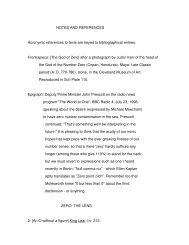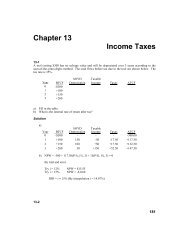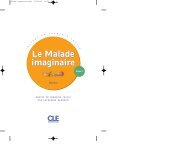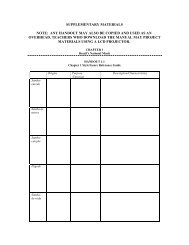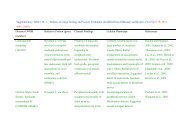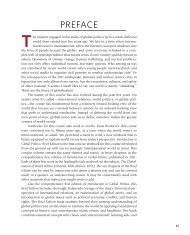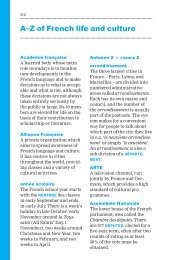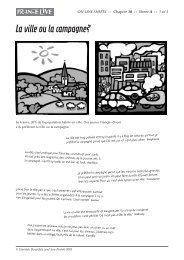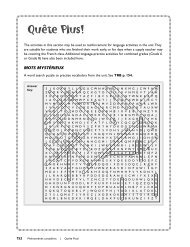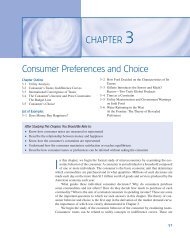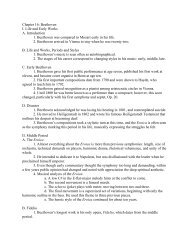Big Writing - Oxford University Press
Big Writing - Oxford University Press
Big Writing - Oxford University Press
Create successful ePaper yourself
Turn your PDF publications into a flip-book with our unique Google optimized e-Paper software.
Using Project X<br />
to support <strong>Big</strong> <strong>Writing</strong> Teaching<br />
by Katie Wilkes and Janice Pimm
Contents<br />
Introduction ..............................................2<br />
The <strong>Big</strong> <strong>Writing</strong> Methodology ...............3<br />
<strong>Big</strong> <strong>Writing</strong> at a Glance ...........................4<br />
How to Use Project X with <strong>Big</strong> <strong>Writing</strong> ..6<br />
Lesson Plans:<br />
Year 3 .....................................................8<br />
Year 4 .....................................................10<br />
Year 5 .....................................................12<br />
Year 6 .....................................................14<br />
Resource Sheets .......................................16<br />
1
Using Project X with <strong>Big</strong> <strong>Writing</strong><br />
Introduction<br />
<strong>Big</strong> <strong>Writing</strong> and Project X share many values. Both have at heart a belief that<br />
children succeed best when they are highly motivated, actively involved in<br />
their own learning journey and challenged to an appropriate degree.<br />
‘Talk’ is central to both <strong>Big</strong> <strong>Writing</strong> and Project X: while <strong>Big</strong> <strong>Writing</strong> encourages<br />
the development of the ‘writing voice’ through fun and lively oral activities,<br />
Project X provides many opportunities for children to talk about the books they<br />
read, recognising that discussion helps children become engaged, reflective<br />
readers. Both Project X and <strong>Big</strong> <strong>Writing</strong> have a special focus on engaging<br />
boys, with action-packed stories in Project X and action-packed activities in<br />
<strong>Big</strong> <strong>Writing</strong> plus a shared understanding that boys need clear learning targets<br />
broken into manageable steps.<br />
With so many values in common, it is not surprising to find that some schools<br />
using Project X have often also implemented the <strong>Big</strong> <strong>Writing</strong> methodology. We<br />
have heard from many teachers wishing, “If only there was something to help<br />
us link Project X with <strong>Big</strong> <strong>Writing</strong>…”. This booklet – written by a head teacher<br />
whose school does just that – is intended to meet that need.<br />
On pages 6-7 you will find suggestions for how to use Project X with <strong>Big</strong> <strong>Writing</strong><br />
and on pages 8-15 you will find sample plans for <strong>Big</strong> <strong>Writing</strong> sessions using<br />
Project X characters, themes and books. On pages 16-24 there are Resource<br />
Sheets linked to the plans. Some of these resources are also available<br />
electronically at www.oxfordprimary.co.uk/projectx<br />
The plans are very much intended<br />
to be a springboard to whet your<br />
appetite – we’re sure you’ll<br />
go on to develop lots<br />
more links and exciting<br />
lessons of your own.<br />
Ros Wilson Andrea Quincey<br />
Creator, <strong>Big</strong> <strong>Writing</strong> Publisher, Project X<br />
2 Find out more at www.oxfordprimary.co.uk
Using Project X with <strong>Big</strong> <strong>Writing</strong><br />
The <strong>Big</strong> <strong>Writing</strong><br />
Methodology<br />
The <strong>Writing</strong> Voice<br />
At the heart of <strong>Big</strong> <strong>Writing</strong> is the development of the writing voice;<br />
that is, the ‘voice’ you need to have in your head to help you<br />
compose the more formal, higher level language and grammatical<br />
structures needed for writing. The method is based on the premise<br />
that “if a child can’t say it, a child can’t write it!”<br />
VCOP<br />
Four ‘generic targets’: Vocabulary, Connectives, Openers and<br />
Punctuation (VCOP) are integral to the development of writing voice<br />
in <strong>Big</strong> <strong>Writing</strong>. The level of a child’s writing improves when s/he uses<br />
vocabulary, connectives, openers and punctuation in increasingly<br />
sophisticated ways. Therefore, VCOP should be taught often and<br />
systematically in lively, fun ways.<br />
The Criterion Scale<br />
Also central to <strong>Big</strong> <strong>Writing</strong> is the Criterion Scale, a formative<br />
assessment scale. When used to assess a piece of unsupported<br />
writing, it tells the assessor what the pupil can do and what the<br />
pupil needs to do next to improve. The assessment is shared with the<br />
pupil who is then reminded of his/her targets every time s/he writes.<br />
Being involved in their own learning and assessment is empowering<br />
for pupils because they can see how to improve their writing by<br />
progressing up the skills scale in clear, bite-sized steps.<br />
Timetable for <strong>Big</strong> <strong>Writing</strong><br />
A <strong>Big</strong> <strong>Writing</strong> session takes place once a week, usually towards the<br />
end of the week. Throughout the rest of the week, teachers also find<br />
time for lively VCOP activities, to practise talking with the writing<br />
voice and to ‘up-level’ text. (This time is known in <strong>Big</strong> <strong>Writing</strong> as<br />
Stocking Fillers.)<br />
Bells Work is the time between packing up and just before the bell<br />
goes that can be used for quick oral VCOP activities. Ten minutes each<br />
day should also be spent practising Basic Skills, including spelling<br />
and handwriting.<br />
The <strong>Big</strong> <strong>Writing</strong> Session<br />
The first forty-five minute session is<br />
thirty-five minutes of fast, fun, lively,<br />
oral activities to develop VCOP. There<br />
is then time for pupils to consolidate<br />
their ideas and plan what to write in the<br />
second session.<br />
Then it’s playtime!<br />
Pupils return to the classroom for 45<br />
minutes of silent writing. A ‘<strong>Big</strong> Write’<br />
atmosphere is created in the classroom<br />
(candles, dimmed lights, soft music etc.)<br />
Find out more!<br />
You can read more about the<br />
<strong>Big</strong> <strong>Writing</strong> approach in the following<br />
books available from OUP - visit<br />
www.oxfordprimary.co.uk<br />
- Talk the <strong>Big</strong> Talk by Ros Wilson<br />
- Raising <strong>Writing</strong> Standards<br />
A Powerful and Effective Whole-School<br />
Approach by Ros Wilson<br />
- <strong>Writing</strong> Voice and Basic Skills<br />
The Class Teacher’s Guide to <strong>Big</strong> <strong>Writing</strong><br />
by Ros Wilson<br />
Or visit www.andrelleducation.co.uk for<br />
information on <strong>Big</strong> <strong>Writing</strong> professional<br />
development courses.<br />
Find out more at www.oxfordprimary.co.uk 3
Using Project X with <strong>Big</strong> <strong>Writing</strong><br />
<strong>Big</strong> <strong>Writing</strong> at a Glance<br />
Basic Skills take 10 minutes<br />
a day throughout Key Stage 2<br />
30 -35 mins<br />
ORAL session<br />
weekly<br />
The <strong>Big</strong> Write<br />
SILENT WRITING session<br />
45 mins (Years 2-6)<br />
30 mins (Year 1)<br />
4 Find out more at www.oxfordprimary.co.uk
Using Project X with <strong>Big</strong> <strong>Writing</strong><br />
Find out more at www.oxfordprimary.co.uk 5
Using Project X with <strong>Big</strong> <strong>Writing</strong><br />
How to Use Project X<br />
with <strong>Big</strong> <strong>Writing</strong><br />
There are all sorts of fun and lively ways to bring Project X into your <strong>Big</strong> <strong>Writing</strong> sessions.<br />
Here are some suggestions:<br />
VCOP Character Champions<br />
Each main Project X character becomes the champion for one aspect of VCOP.<br />
When children are asked to identify or produce aspects of VCOP they could wear the<br />
appropriate character badges. VCOP Character Champion badges are supplied in colour<br />
on the back page of this booklet and at www.oxfordprimary.co.uk/projectx<br />
Tiger = Vocabular y<br />
Max = Openers<br />
Cat = Connectives<br />
Ant = Punctuation<br />
Using Dani Day in<br />
‘posh talk’ sessions<br />
‘Posh talk’ in <strong>Big</strong> <strong>Writing</strong> is a fun way of helping children to develop a formal writing<br />
voice. You could use the Project X character Dani Day as a starting point for<br />
‘posh talk’.<br />
Dani Day visits the classroom. The teacher or selected children could take on<br />
the role of Dani Day or you could project in image of Dani Day on the IWB.<br />
Explain to children that it is important for them to use ‘posh voice’ when<br />
speaking to Dani Day.<br />
6 Find out more at www.oxfordprimary.co.uk
Using Project X with <strong>Big</strong> <strong>Writing</strong><br />
Using Project X Characters<br />
as the imaginary friend<br />
In <strong>Big</strong> <strong>Writing</strong>, the imaginary friend answers the questions that no-one else in the class can<br />
answer, makes the mistakes that pupils in the class make (so protecting their self-esteem)<br />
and writes at low levels so the class can discuss how he/she can move the writing up one<br />
or more levels. Max, Cat, Ant and Tiger could take it in turns to be the ‘imaginary friend’.<br />
Alternatively, you could use other characters such as Plug and Socket (who often get things<br />
wrong!) to be the imaginary friend. You could project up images of the imaginary friend on<br />
the IWB.<br />
Using Project X resources as<br />
stimuli for talk and writing<br />
In the ‘Talk’ sections of Project X Software you will find a wealth of images<br />
(pictures and photographs) that can be used as the stimulus for talk and writing.<br />
In the software for Years 5 and 6 you will find structured sessions for guided<br />
debate and discussion. (See Project X Interactive Stories, Year 2, Years 3-4 and<br />
Project X Interactive Years 5 and 6).<br />
Using Project X for<br />
‘<strong>Big</strong> it Up’ Monday<br />
On ‘<strong>Big</strong> it Up’ Monday, instead of re-telling what they did on an ordinary weekend, children<br />
are encouraged to imagine what they could have done. This helps children to increase<br />
their use of the ‘writing voice’ during their oral recounts and to have fun with language and<br />
making up stories. Children could be asked to imagine adventures where they shrink like<br />
Project X characters.<br />
Project X at the heart<br />
of <strong>Big</strong> <strong>Writing</strong> Sessions<br />
Sample plans<br />
On pages 8-15 you will find sample lesson plans illustrating how you might use Project X<br />
within your literacy units and within selected <strong>Big</strong> <strong>Writing</strong> sessions.<br />
There is one plan for each of Years 3 to 6. In each, we have suggested some thematicallylinked<br />
VCOP activities, a ‘talk homework’ and a <strong>Big</strong> <strong>Writing</strong> session. We have also provided<br />
accompanying resource sheets on pages 16-24.<br />
These plans are very much a ‘springboard’ to help you think about ways to use Project X and<br />
<strong>Big</strong> <strong>Writing</strong> together. We imagine that alongside these plans you would also carry out all<br />
of your usual <strong>Big</strong> <strong>Writing</strong> activities (e.g. target setting, additional Stocking Fillers and talk<br />
activities during the week).<br />
Find out more at www.oxfordprimary.co.uk 7
Lesson Plans<br />
Year 3<br />
PX Cluster Theme<br />
Fast and Furious<br />
PX Focus Text(s) The Chase by Anthony McGowan<br />
LEARNING INTENTIONS: improve use of openers,<br />
ambitious vocabulary; write an adventure story with a<br />
clear beginning, middle and end.<br />
8 Using Project X with <strong>Big</strong> <strong>Writing</strong> Year 3<br />
Linked Literacy Theme<br />
Adventure and Mystery<br />
PRIOR KNOWLEDGE: story structure; paragraphs;<br />
full stop, question, exclamation marks, speech<br />
punctuation<br />
As part of your literacy lessons, read The Chase with the whole class. During class discussion<br />
focus on how the author creates tension and a sense of adventure. Collect and display powerful<br />
sentence openings (e.g. ‘Down in the drains…’, ‘The X-bot spun around to…’).<br />
VCOP Activities<br />
You can use these activities as Stocking Fillers in the week preceding your <strong>Big</strong> <strong>Writing</strong> session<br />
or choose to incorporate some into session 1 of your <strong>Big</strong> <strong>Writing</strong> day.<br />
Quick-fire<br />
openers<br />
Quick-fire<br />
Highlighting<br />
VCOP<br />
Up-levelling<br />
Posh Voice<br />
TALK HOMEWORK<br />
What is the best way to finish these sentences? Up in the sky… /He turned<br />
round and…, /She couldn’t believe it when… /Finally…<br />
Would you use a question mark, exclamation mark or full stop at the end of<br />
these sentences? ‘What’s the plan?’/Cat checked her watch./’Help, it’s got my<br />
watch!/Why did he feel so strange?/He was a fast skateboarder./’Let’s run!’<br />
Organise the children into groups of four. One child in each group will take<br />
on the role of Tiger (Vocabulary), Cat (Connectives), Max (Openers) or Ant<br />
(Punctuation). Provide each group with an enlarged passage from the<br />
book (e.g. page 28 or pages 36-37). Each character then highlights the<br />
appropriate part of the text for his or her area of expertise. Allow time for<br />
feedback to group/class.<br />
Cat wrote a short recount of her adventure with the pigeons but she needs<br />
some help to turn it into an exciting piece of writing. Display Resource<br />
Sheet 1 Part A and work as a class to up-level the text. You can compare the<br />
version on page 30.<br />
Teacher takes on the role of Dani Day (posh voice). She is amazed that Team<br />
X managed to get the watch back from the X-bot and wants to know the<br />
details. Children reply to these questions using ‘posh voice’: Explain what<br />
happened when Tiger noticed his watch was missing. How did he feel?<br />
Please recount the events that happened to Tiger on his skateboard.<br />
Now please recount what happened to Max and Ant. How was the X-bot<br />
eventually defeated?<br />
Children ask relatives or friends if they have ever lost anything precious.<br />
What happened? How did they feel about the loss? Did they get it back?<br />
Resources<br />
Punctuation Fan<br />
VCOP Character<br />
Badges:<br />
(on back cover)<br />
Resource Sheet 1
Lesson Plans<br />
BIG WRITING DAY session 1 (approx. 35-40 minutes)<br />
Learning Objectives<br />
I can use powerful openings. I can use paragraphs.<br />
Warm up<br />
Quick Punctuation<br />
Paragraphs<br />
Openers<br />
Hotseat<br />
Story Structure<br />
Paragraph openings<br />
Planning<br />
BREAK<br />
Choose VCOP quick-fire activities from the activities above<br />
or similar.<br />
Display Resource Sheet 1 Part B. Read the sentences and ask<br />
children to insert appropriate punctuation.<br />
Display The Chase page 31. Ask children to identify paragraph<br />
openings. Remind children why we use paragraphs.<br />
Display Resource Sheet 2. Ask children which opening makes<br />
you want to read further. Why? Ask children to<br />
highlight VCOP.<br />
Divide class into groups. Give each group character cards and<br />
object cards. Each group selects one object and one character<br />
and imagines where, how, when and why the character loses<br />
that object (or has it stolen). Each group orally rehearses a<br />
story opening based on the character and the lost object.<br />
Share with class.<br />
Ask a member of each group to come up in ‘role’ as the<br />
character who has lost an object. How does he/she feel?<br />
Can he/she get the object back? Does he/she need to chase<br />
someone for it/need help to get it back?<br />
As a whole class, choose one of the characters and one of the<br />
objects. Use the Story planner on Resource Sheet 4 to plan an<br />
adventure story with the title Lost and Found.<br />
Organize the planned story content into paragraphs. See how<br />
many different sentence openings children can produce orally<br />
for the first sentence of each paragraph (perhaps with a time<br />
limit for each one).<br />
Explain that the <strong>Big</strong> <strong>Writing</strong> session after the break will be<br />
an adventure story about someone who has lost something<br />
precious or had something stolen and how how she/he gets<br />
it back. Give children 5 minutes to plan their own stories (use<br />
story planning tools of your choice).<br />
BIG WRITING DAY Session 2 (approx. 45-50 mins) <strong>Big</strong> Write: music, candles etc.<br />
Learning Objectives<br />
I can write an adventure story with a clear beginning, middle and end using paragraphs and<br />
interesting openers. I can recognise good features in my partner’s work.<br />
Children come back into the classroom to write an adventure story titled: Lost and Found.<br />
Stop after 10 minutes and ask Who has used an interesting sentence opener? Who has used<br />
more than one type of punctuation? Praise. Hold second review after about 15 minutes and<br />
give 5 minute/2 minute warnings towards the end. During plenary pupils partner-review and<br />
highlight interesting openers and examples of VCOP in each other’s work. Review objectives.<br />
Resource Sheet 1<br />
Part B<br />
Resource Sheet 2<br />
Resource Sheet 3<br />
Resource Sheet 4<br />
Using Project X with <strong>Big</strong> <strong>Writing</strong> Year 3 9
Lesson Plans<br />
Year 4<br />
PX Cluster Theme<br />
In The News<br />
PX Focus Text: Making A Splash by Chloe Rhodes<br />
LEARNING INTENTIONS: improve use of connectives,<br />
ambitious vocabulary; write an eye-witness account.<br />
10 Using Project X with <strong>Big</strong> <strong>Writing</strong> Year 4<br />
Linked Literacy Theme<br />
Non Fiction Newspaper Reports<br />
PRIOR KNOWLEDGE: features of a newspaper report;<br />
paragraphs; full stop; commas in lists; connectives<br />
and time connectives.<br />
As part of your literacy lessons, read Making A Splash with the whole class. During class<br />
discussion focus on features of non fiction texts, such as a contents page, bullet points, sub<br />
titles, diagrams, flow charts, text boxes, photographs with captions. Collect wow words and<br />
connectives and display.<br />
VCOP Activities<br />
You can use these activities as ‘Stocking Fillers’ in the week preceding your <strong>Big</strong> <strong>Writing</strong> session<br />
or choose to incorporate some into Session 1 of your <strong>Big</strong> <strong>Writing</strong> day. Note that the Uplevelling, Highlighting and<br />
Posh Voice activities need to be completed prior to teaching the <strong>Big</strong> <strong>Writing</strong> session<br />
Resources<br />
Quick-fire<br />
connectives<br />
Quick-fire<br />
punctuation<br />
Up-level<br />
Highlighting<br />
VCOP<br />
Posh Voice<br />
TALK HOMEWORK<br />
Can you find a connective to link these two sentences together? I have a<br />
dog. I have a cat./ I have a dog. I haven’t got a cat./ I had a lovely holiday.<br />
It rained most days.<br />
Can you insert commas into these sentences? For lunch today we will be<br />
having roast beef, Yorkshire pudding, roast potatoes and vegetables./ An<br />
alien has landed on planet Earth this morning. He was described as having<br />
green hair, four eyes and silver antlers.<br />
Some local children went to see the whale in the Thames and wrote a report<br />
on it for their school newspaper, but they need some help with connectives.<br />
In pairs, annotate the passage and insert some connectives.<br />
Organize the children into groups of four. One child in each group will take<br />
on the role of Tiger (Vocabulary), Cat (Connectives), Max (Openers) or Ant<br />
(Punctuation). Provide each group with an enlarged copy of page 29 in the<br />
book. Each character then highlights the appropriate part of the text for his<br />
or her area of expertise. Allow time for feedback to group/class.<br />
Teacher takes on the role of Dani Day (posh voice). She has visited the<br />
Thames to see the whale in the river. How would she describe this event to<br />
Max, Ant, Tiger and Cat? Work in pairs, taking it in turns to adopt the ‘posh<br />
voice’ of Dani.<br />
Children ask relatives or friends for their views on animals being hunted for their fur, skin or<br />
tusks. What are their views on fox hunting?<br />
Resource Sheet 5<br />
VCOP Character<br />
Badges (on back<br />
cover)
Lesson Plans<br />
BIG WRITING DAY session 1 (approx. 35-40 minutes)<br />
Learning Objectives<br />
I can produce an oral news report. I can use powerful openings and a range of wow words.<br />
Warm up<br />
Quick Connectives<br />
Drama Activities -<br />
Guided Tour<br />
Openers<br />
Drama Planning<br />
BREAK<br />
Choose VCOP quick-fire activities from the activities above<br />
or similar.<br />
In pairs, ask the children to play Ping Pong Connectives using<br />
a description of a typical day for them. Child A begins with e.g.<br />
‘Firstly, the alarm went off and I woke up.’ Child B responds<br />
with ‘Next, I got up and went to the toilet’, etc.<br />
Display pictures of the whale in the Thames from the book.<br />
In pairs, invite the children to take their partner (with eyes<br />
closed) on a ‘guided tour’ of the event. As they stand at a<br />
barrier overlooking the river, what can they see? What can<br />
they hear and smell? How do they feel? Emphasise use of wow<br />
words to describe the setting and the spectacle. Swap over.<br />
Compare experiences.<br />
Read the comments from people following the plight of the<br />
whale on page 14. Invite children to contribute to an online<br />
discussion, bringing post it notes to the front of the class.<br />
Think about a sentence opener which will grab the audience’s<br />
attention. Can they start with a ly, ed or ing word?<br />
Ask the children to produce a short television news report<br />
on the plight of the whale. Explain that their broadcast is to<br />
include an interview with an eye witness. Allow 10 minutes for<br />
the children to decide on content and rehearse their bulletin.<br />
Encourage ‘posh voice’ and use of connectives. ‘Broadcast’ to<br />
the rest of the class and invite constructive criticism.<br />
Explain that after break, the children will be writing an eye<br />
witness account of the whale as if they had seen it. Allow time<br />
for thinking and planning.<br />
BIG WRITING DAY Session 2 (approx. 45-50 mins) <strong>Big</strong> Write: music, candles etc.<br />
Learning Objectives<br />
I can write an eye witness account. I can use powerful openings and a range of wow words.<br />
I can recognize good features in my partner’s work and in my own work.<br />
Children come back into the classroom to write an eye witness account of the whale in the Thames.<br />
Resource Sheet 6<br />
Enlarged copy of<br />
Making a Splash<br />
page 14. Post-it<br />
notes.<br />
Stop after 10 minutes and ask Who has used an interesting sentence opener? Who has used more than one type<br />
of punctuation? Who has used a range of time connectives? Hold second review after about 15 minutes and give<br />
5 minute/2 minute warnings towards the end. During plenary pupils partner-review and highlight interesting<br />
openers and examples of VCOP in each other’s work. Review objectives.<br />
Using Project X with <strong>Big</strong> <strong>Writing</strong>Year 4 11
Lesson Plans<br />
Year 5<br />
PX Cluster Theme<br />
Endangered<br />
PX Focus Text: The Amazon by Deborah Chancellor<br />
LEARNING INTENTIONS: improve use of commas in a list;<br />
ambitious vocabulary; write an information leaflet.<br />
12 Using Project X with <strong>Big</strong> <strong>Writing</strong> Year 5<br />
Linked Literacy Theme<br />
Non Fiction Persuasive <strong>Writing</strong><br />
PRIOR KNOWLEDGE: features of an information leaflet;<br />
paragraphs; full stop; commas in a list; connectives<br />
and time connectives.<br />
As part of your literacy lessons, read The Amazon with the whole class. During class discussion focus on<br />
features of non fiction texts, such as contents page, bullet points, sub titles, diagrams, flow charts, text<br />
boxes, photographs with captions. Collect wow words, connectives and display.<br />
VCOP Activities<br />
You can use these activities as ‘Stocking Fillers’ in the week preceding your <strong>Big</strong> <strong>Writing</strong> session<br />
or choose to incorporate some into session 1 of your <strong>Big</strong> <strong>Writing</strong> day.<br />
Quick-fire<br />
openers<br />
Quick-fire<br />
punctuation<br />
Up-level<br />
Highlighting<br />
VCOP<br />
TALK HOMEWORK<br />
Look at the sentences on Resource Sheet 7. Which openings are the most<br />
effective? Why? Ask children to find a sentence of their own from the last<br />
<strong>Big</strong> <strong>Writing</strong> Session to re-arrange in the same way.<br />
Display copies of the Amazing Facts on pages 11-13 of The Amazon and<br />
look particularly at the use of a colon to introduce further information.<br />
‘Kung Fu punctuate’ one of the cards, then provide the class with further<br />
oral examples, asking them to ‘Kung Fu punctuate’ the colon and any other<br />
relevant punctuation that occurs.<br />
Give the children copies of the re-written email on Resource Sheet 8 (original<br />
is on page 7 of the book) and ask them to up-level the writing, paying<br />
attention to VCOP.<br />
Organize the children into groups of four. One child in each group will take<br />
on the role of Tiger (Vocabulary), Cat (Connectives), Max (Openers) or Ant<br />
(Punctuation). Provide each group with an enlarged copy of page 13 in the<br />
book. Each character then highlights the appropriate part of the text for his<br />
or her area of expertise. Allow time for feedback to group/class.<br />
Children ask relatives or friends for their views on the destruction of the rainforests. Do they<br />
know anyone who chooses not to buy goods that have contributed to this destruction? If not,<br />
why do they think people have not made this choice?<br />
Resources<br />
Resource Sheet 7<br />
Punctuation<br />
Fans/Kung Fu<br />
punctuation<br />
Resource Sheet 8<br />
VCOP Character<br />
Badges (on back<br />
cover)
Lesson Plans<br />
Year 6<br />
PX Cluster Theme<br />
Unexplained<br />
PX Focus Text: Tasmanian Terror by Anthony McGowan<br />
LEARNING INTENTIONS: use a range of drama and<br />
speaking and listening strategies to explore a text;<br />
produce a recount of events from a character’s point<br />
of view.<br />
14 Using Project X with <strong>Big</strong> <strong>Writing</strong> Year 6<br />
Linked Literacy Theme<br />
Chronological Report <strong>Writing</strong><br />
PRIOR KNOWLEDGE: story structure; paragraphs;<br />
speech punctuation.<br />
As part of your literacy lessons, read Tasmanian Terror with the whole class. During class discussion<br />
focus on how the author creates tension and a sense of adventure. Collect and display powerful sentence<br />
openings and ambitious vocabulary.<br />
VCOP Activities<br />
You can use these activities as ‘Stocking Fillers’ in the week preceding your <strong>Big</strong> <strong>Writing</strong> session<br />
or choose to incorporate some into session 1 of your <strong>Big</strong> <strong>Writing</strong> day.<br />
Quick-fire<br />
openers<br />
Quick-fire<br />
punctuation<br />
Highlighting<br />
VCOP<br />
Up-level<br />
Posh Voice<br />
TALK HOMEWORK<br />
What is the best way to finish this sentence? What worried Mr Unwin was…<br />
/At that moment…, /The ground trembled…/And from now on…/Towering<br />
over them…<br />
Would you use a question mark, exclamation mark or full stop at the<br />
end of these sentences? What on earth was that?’/You’ve got to be<br />
kidding!/’Rocks that aren’t there?<br />
Display these sentences without commas and ask children to insert the<br />
commas. There was a big door, through which the farmer had gone, and<br />
a smaller door at the side, slightly ajar./Beside it, standing on a stepladder,<br />
the farmer was using the hedge trimmer to shear wool from its<br />
side.<br />
Organize the children into groups of four. One child in each group will<br />
take on the role of Tiger (Vocabulary), Cat (Connectives), Max (Openers) or<br />
Ant (Punctuation). Provide each group with an enlarged passage from the<br />
book (e.g. pages 40-41). Each character then highlights the appropriate<br />
part of the text for his or her area of expertise. Allow time for feedback to<br />
group/class.<br />
Max wrote a short recount of his adventure in Tasmania but he needs some<br />
help to turn it into an exciting piece of writing. Display and work as a class<br />
to uplevel the text. You can compare the version on Tasmanian Terror page<br />
30.<br />
Teacher now takes on the role of Dani Day (Posh Voice) In groups of four,<br />
(VCOP representatives) the children need to work collaboratively to prepare a<br />
2 -4 minute oral presentation to Dani on the events of the book. Emphasis on<br />
VCOP and Posh Talk.<br />
Children ask relatives or friends if they have ever been very fond of an animal? What animal<br />
was it? What did they do to care for it? How did they feel about the animal?<br />
Resources<br />
Punctuation<br />
Fans/Kung Fu<br />
punctuation<br />
VCOP Character<br />
Badges (on back<br />
cover)<br />
Resource Sheet<br />
9 Part A
Lesson Plans<br />
BIG WRITING DAY session 1 (approx. 35-40 minutes)<br />
Learning Objectives<br />
I can use powerful openings. I can use commas and speech marks.<br />
Warm up<br />
Quick Punctuation<br />
Revising story<br />
language and story<br />
structure<br />
Conscience Alley<br />
Planning<br />
BREAK<br />
Choose VCOP quick-fire activities from the activities above<br />
or similar.<br />
Display Resource Sheet 9 Part B. Read the sentences and<br />
ask children to display appropriate punctuation. Review<br />
speech punctuation.<br />
In pairs, labelled A and B, ask the children to take turns re<br />
telling the story to each other. Emphasise it is vital that<br />
nothing is missed out and nothing is repeated, so it is<br />
important to listen as well as to speak. Emphasise using ‘story<br />
language’ throughout.<br />
Re read Chapter 1. Allow the children 5 minutes to discuss<br />
what Mr Unwin discovers after this chapter and what he<br />
decides to do about it. Present two of Mr Unwin’s options to the<br />
class, e.g. a) to keep quiet about what is happening in case it<br />
affects his business or b) to inform the authorities about what<br />
is going on for the good of the local area. Invite the children to<br />
form an ‘alley’ and a child to play Mr Unwin. ‘Mr Unwin’ walks<br />
up and down conscience alley, while the children on the<br />
right side shout things to convince him to keep quiet and<br />
the children on the left shout things to convince him to tell<br />
the authorities. Ask ‘Mr Unwin’ what he will do and which<br />
arguments convinced him.<br />
In role as Dani Day, explain to the class that you need a<br />
detailed written report of what happened in the story written<br />
from Mr Unwin’s point of view. Remind the children that some<br />
things were hidden from the Unwins, such as when the watches<br />
shrunk both Mr Unwin and the animals. How would Mr Unwin<br />
report that?<br />
BIG WRITING DAY Session 2 (approx. 45-50 mins) <strong>Big</strong> Write: music, candles etc.<br />
Learning Objectives<br />
I can write a report of events from a character’s point of view.<br />
Resource Sheet 9<br />
Part B.<br />
Children come back into the classroom to write a report of what happened in the story from Mr Unwin’s point of<br />
view. Stop and review at regular intervals. Pupils partner-review in plenary.<br />
Using Project X with <strong>Big</strong> <strong>Writing</strong> Year 6 15
Resource Sheet 1<br />
Part A<br />
Cat’s recount<br />
I was in the micro-copter. I flew round<br />
a corner. I flew into some pigeons.<br />
The pigeons were scared. They were<br />
scared of the micro-copter. I didn’t<br />
want to hit the pigeons. I moved the<br />
micro-copter out of their way.<br />
Part B<br />
Punctuation<br />
A trap Max shouted<br />
The X-bots moved towards the children<br />
What shall we do yelled Ant<br />
16 Project X with <strong>Big</strong> <strong>Writing</strong> Resources © <strong>Oxford</strong> <strong>University</strong> <strong>Press</strong>, 2012
Resource Sheet 2<br />
Chapter Opening 1<br />
Max and Ant were in the drains. They walked<br />
along the tunnel. They saw a red light ahead.<br />
“Look,” said Max.<br />
Chapter Opening 2<br />
Down in the drains, Max and Ant crept<br />
further down the tunnel. There was a faint<br />
red light ahead.<br />
“Look,” whispered Max.<br />
© <strong>Oxford</strong> <strong>University</strong> <strong>Press</strong>, 2012 Project X with <strong>Big</strong> <strong>Writing</strong> Resources 17
Resource Sheet 3<br />
Old man with<br />
shopping<br />
Necklace or ring In the park<br />
Girl on skateboard Soft toy At the seaside<br />
Boy on bike Wallet or purse At the shops<br />
Small child Dog At a sports match<br />
Lady with case Letter In school playground<br />
Boy in shorts Bike In the garden<br />
Girl in school uniform Cat Inside the house<br />
Child in tracksuit Game console In the woods<br />
18 Project X with <strong>Big</strong> <strong>Writing</strong> Resources © <strong>Oxford</strong> <strong>University</strong> <strong>Press</strong>, 2012
Resource Sheet 4<br />
Opening: Where is<br />
the story set? Who has<br />
lost something? What is it?<br />
Para 3: Does he/she have to act<br />
quickly to get it back? Or does<br />
he/she need a plan to get it<br />
back? Can anyone help?<br />
Para 5: How does the character<br />
get the object back in the end?<br />
How does he/she feel now?<br />
Para 2: Where might the object<br />
be lost? Who might have taken<br />
it? Has it only just gone?<br />
Para 4: What happens while<br />
the character is trying to get<br />
the object back? What gets in<br />
the way?<br />
© <strong>Oxford</strong> <strong>University</strong> <strong>Press</strong>, 2012 Project X with <strong>Big</strong> <strong>Writing</strong> Resources 19
Resource Sheet 5<br />
Our Trip To See The Whale<br />
We were at school. We heard<br />
about the whale in the Thames.<br />
Our teacher told us. We thought<br />
she was lying. We couldn’t see<br />
anything. We thought it was a<br />
waste of time. We got further<br />
down. We could see a crowd.<br />
We could see cameramen,<br />
photographers and reporters.<br />
We walked past Albert Bridge<br />
and then we could see the whale.<br />
20 Project X with <strong>Big</strong> <strong>Writing</strong> Resources © <strong>Oxford</strong> <strong>University</strong> <strong>Press</strong>, 2012
Lesson Plans<br />
BIG WRITING DAY session 1 (approx. 35-40 minutes)<br />
Learning Objectives<br />
I can use powerful openings and a range of wow words. I can present a short oral presentation to a group.<br />
Warm up<br />
Quick Punctuation<br />
Talk/Posh Voice<br />
Openers<br />
Planning<br />
BREAK<br />
Choose VCOP quick-fire activities from the activities above<br />
or similar.<br />
Display these sentences without the commas and ask the<br />
children in pairs to insert the commas;<br />
The anaconda is usually solitary, but it is sometimes found<br />
in groups. It feeds on fish, amphibians, snakes, reptiles and<br />
mammals. When it catches its prey, the anaconda coils around<br />
the prey until it suffocates.<br />
Transform pages 18–19 into cards, one for each animal, and<br />
give one card to each group. In role as Dani Day (Posh Voice),<br />
explain that the groups are to be given 5 minutes to prepare<br />
an oral presentation about their animal. Emphasise use of the<br />
Posh Voice. Each group presents to the class. Invite rest of<br />
class to make notes on each presentation. They will need these<br />
notes for their own writing.<br />
Ask each group to compare their notes on a specific<br />
presentation from another group. In pairs or in fours, they<br />
are to transform these notes into sentences using a range of<br />
openers. Can they start with an ‘ing’ word or ‘ed’ word? Can<br />
they start with subordination?<br />
Explain that after break, the children will be writing an<br />
information leaflet on the Amazonian Rainforest. Allow time<br />
to brainstorm as a group and begin individual planning.<br />
Provide the children with a range of reference books and<br />
ideally access to the internet in order to research further.<br />
BIG WRITING DAY Session 2 (approx. 45-50 mins) <strong>Big</strong> Write: music, candles etc.<br />
Learning Objectives<br />
I can write an information leaflet. I can use powerful openings. I can use commas to break up<br />
parts of a sentence and commas in a list. I can use colons to introduce information.<br />
Children come back into the classroom to write an Information leaflet on the Amazonian Rainforest.<br />
Copies of card made<br />
from The Amazon<br />
pages 18 and 19<br />
Stop after 10 minutes and ask Who has used an interesting sentence opener? Who has used more than one type of<br />
punctuation? Praise. Hold second review after about 15 minutes and give 5 minute/2 minute warnings towards the<br />
end. During plenary pupils partner-review and highlight interesting openers and examples of VCOP in each other’s<br />
work. Review objectives.<br />
Using Project X with <strong>Big</strong> <strong>Writing</strong> Year 5 13
Resource Sheet 6<br />
Ping Pong Connective Cards<br />
Firstly<br />
Next<br />
But<br />
Because<br />
Then<br />
However<br />
Although<br />
Finally<br />
© <strong>Oxford</strong> <strong>University</strong> <strong>Press</strong>, 2012 Project X with <strong>Big</strong> <strong>Writing</strong> Resources 21
Resource Sheet 7<br />
Openings<br />
Rainforests will disappear in<br />
under fifty years if nobody<br />
stands up to protect them.<br />
If nobody stands up to protect<br />
the rainforests, they will<br />
disappear in under fifty years.<br />
Climate change gets worse<br />
as rainforests disappear.<br />
As rainforests disappear,<br />
climate change gets worse.<br />
22 Project X with <strong>Big</strong> <strong>Writing</strong> Resources © <strong>Oxford</strong> <strong>University</strong> <strong>Press</strong>, 2012
Resource Sheet 8<br />
E Mail from Auntie Sarah<br />
Hello tom<br />
My work in the amazon rainforest is exciting.<br />
I find new plant types every day. I have<br />
just found a new type of fig tree. Did you<br />
know that amazonion indians use over 2000<br />
different types of fruit. We only use 200 fruits.<br />
The 200 fruits come from all of the worlds<br />
rainforests<br />
I have to go now. Ive got to finish writing<br />
a report<br />
Lots of love<br />
Auntie sarah<br />
© <strong>Oxford</strong> <strong>University</strong> <strong>Press</strong>, 2012 Project X with <strong>Big</strong> <strong>Writing</strong> Resources 23
Resource Sheet 9<br />
Part A<br />
My adventure in tasmania by Max<br />
We went to tasmania we found a slime trail.<br />
We found a giant sheep mr unwin had grown a<br />
bit. We used the driller to fix it. We saw a giant<br />
tasmanian devil we used the driller to fix it.<br />
Part B<br />
Run cried Ant<br />
I think its stuck said tiger lets get out through<br />
the back door<br />
Anyone like a slice of cake asked mrs unwin<br />
24 Project X with <strong>Big</strong> <strong>Writing</strong> Resources © <strong>Oxford</strong> <strong>University</strong> <strong>Press</strong>, 2012
3<br />
Using Project X to support<br />
<strong>Big</strong> <strong>Writing</strong> Teaching<br />
Project X and Ros Wilson’s <strong>Big</strong> <strong>Writing</strong> share<br />
many values and are both particularly<br />
powerful in helping boys to succeed.<br />
This booklet is designed to give teachers a ‘taster’<br />
of how the engaging Project X characters and<br />
resources can be used to support <strong>Big</strong> <strong>Writing</strong> in<br />
the classroom. It provides:<br />
• A very brief summary of the <strong>Big</strong> <strong>Writing</strong><br />
approach<br />
• Tips for using the Project X characters<br />
as VCOP champions<br />
• Exemplar lesson plans that show how you<br />
might use Project X to deliver <strong>Big</strong> <strong>Writing</strong><br />
at Key Stage 2<br />
© <strong>Oxford</strong> <strong>University</strong> <strong>Press</strong> 2012<br />
Character artwork by Jon Stuart.<br />
Printed in Great Britain by Ashford Colour <strong>Press</strong> Ltd., Gosport.<br />
How to get in touch:<br />
web www.oxfordprimary.co.uk<br />
email schools.enquiries.uk@oup.com<br />
tel. +44 (0) 1536 452610<br />
fax +44 (0) 1865 313472<br />
INSPIRATIONAL SUPPORT FOR TEACHERS<br />
For professional development plus free<br />
resources and eBooks<br />
www.oxfordprimary.co.uk<br />
Max = Openers<br />
Cat = Connectives<br />
Tiger = Vocabular y<br />
Ant = Punctuation<br />
10 9 8 7 6 5 4 3 2 1


